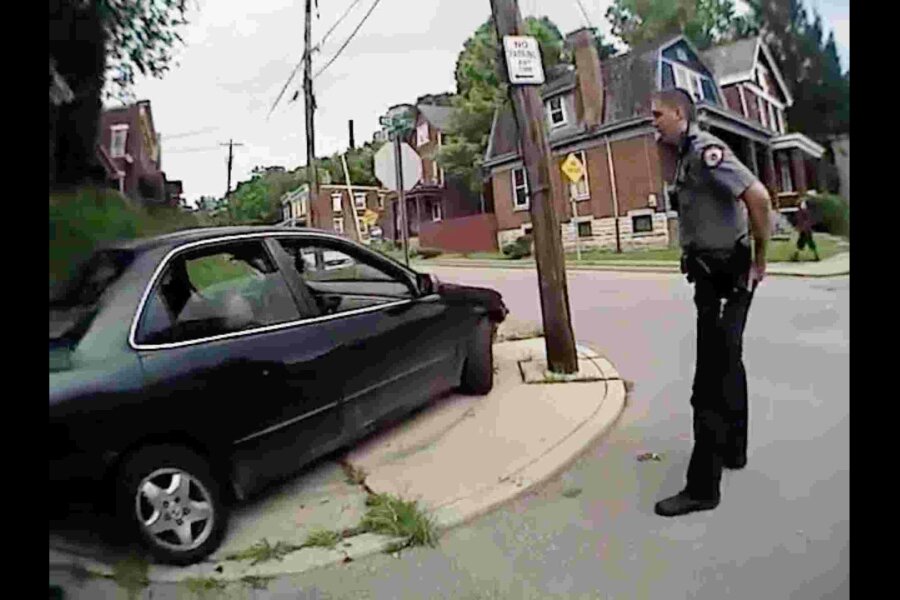Ohio Supreme Court rules that police dashcam videos are public records
Loading...
The Ohio Supreme Court ruled Tuesday that videos recorded by police dashboard cameras are public records subject to prompt release under the state's open records laws, rejecting the state's argument that the footage could be kept confidential because of its status as an investigatory record.
The unanimous decision means police in Ohio must make limited redactions on a case-by-case basis as the law allows, rather than withholding videos in their entirety. And it could signal the way the court might apply current laws to police body-worn camera footage, too. In so doing, the court is grappling with technological innovation and public demands for both transparency and personal privacy – as local and state authorities across the United States do the same.
"This case involved dash-cams, but increasingly, localities in Ohio are adopting body-cams, and I don’t see any distinction there," Dennis Hirsch, law professor and director of the Program on Data and Governance at The Ohio State University Moritz College of Law, tells The Christian Science Monitor in a phone interview. "The precedent here would likely hold for body-cams in the same way that it applies to cameras on the dashboard."
After a high-speed chase last year down Interstate 71, The Cincinnati Enquirer filed a public records request for footage of the 20-minute incident from the perspective of three separate State Highway Patrol vehicles, but their request was denied, as The Columbus Dispatch reported. Since the video documents real-time investigative activity, the records could be kept confidential, the state had argued.
The seven justices, however, ruled Tuesday that the police had erred in withholding approximately an hour of video, when it could have withheld only the small portion in which officers interview the suspect after reading him his rights.
"Our review of the recordings at issue here leads us to conclude that a 90-second portion of the recordings contains specific investigatory work product, but the remainder does not," Justice Judith French wrote in the opinion.
In a separate case pertaining to the shooting of an unarmed black motorist by a white University of Cincinnati police officer, The Cincinnati Enquirer, four local television stations, and The Associated Press have asked the Ohio Supreme Court to rule on whether body-camera footage is similarly a public record. But that case remains pending before the court.
Larry James, general counsel for the National Fraternal Order of Police, was present in the courtroom during oral arguments for both cases. He says the questions pertaining to dashboard camera footage are similar to those relevant in the body-worn camera case.
Since the justices stopped short of providing real clarity in Tuesday's ruling, he says he hopes the forthcoming decision will help police agencies know more precisely when they should be releasing video and how they should assess which portions of it can be appropriately withheld as investigatory.
While it will require some heavy lifting to build the teams and infrastructure necessary to review, redact, and release video footage from dashboard and body-worn cameras pursuant to public records requests, Mr. James says he expects police agencies across the United States will rise to the challenge and eventually bring about the requisite changes.
"I’m not going to say it’s not expensive. And government is going to have to find the money. But it’s just a matter of staffing folks in that police department where that’s their job," James tells the Monitor in a phone interview.
The fact that the Ohio Supreme Court declined to award attorney fees in this case suggests that the justices generally see the initial decision to withhold the video footage as a reasonable one, James says.
"If the government has done anything wrong or mischievous or with ill-motive, then you usually get the award of attorney fees," he says, adding that such costs could easily run into the tens of thousands of dollars.
"There was a time period when it was routine to see attorney fees awarded against public entities because they were playing games and not complying with the spirit and or the letter of the law with regard to public records requests," James says.
In the past few years, especially, video recordings of police encounters with the public have provided an important check, as Americans insist on transparency.
"A government that operates in the dark is a government that people should be concerned about," Adam Bates, a policy analyst for the Cato Institute's Project on Criminal Justice, told the Monitor in August. "I think in the last several years, it’s become very obvious to people across the political spectrum, and across the country, that we have problems in the institutions of policing in this country. And the lack of transparency and the lack of accountability exacerbate those problems."
But the ruling Tuesday should also raise privacy concerns for individual Americans, Professor Hirsch says, arguing that states need to completely revamp their public records laws to catch up with the changing times.
"I think these laws were written for a different era," he says, "and their use is being changed in a harmful way to mandate and force much more disclosure than they were ever intended to disclose."
Most of the exemptions written into state public records laws are for the benefit of law enforcement, leaving innocent bystanders who might not want their likeness broadcast on the local news just because they called police without much protection. That reality is even more disconcerting, he says, when you consider the scope of personal information a body-worn camera collects when an officer enters a private home.
Without a rewrite by the Ohio legislature, however, the rules as applied to dashboard cameras are likely to apply to body-worn cameras as well, Hirsch says.
This report contains material from the Associated Press.






